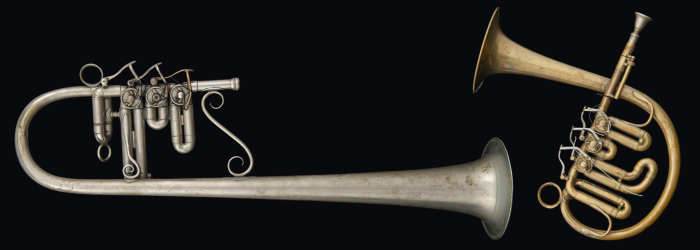Returning the Voices to Our Muted Songbirds

By Scott W. Schwartz, Archivist for Music and Fine Arts and Director Sousa Archives and Center for American Music
My colleagues often tell me music instruments come to museums and archives to die. The curators of these cultural mausoleums often meticulously measure and document every physical detail of their music cadavers. However, they don’t allow them to be played. This essentially robs the instruments of their distinctive voices and mutes our understanding of their unique sound and functions.

An 1862 E-Flat Over the Shoulder Horn (left) and 1860 Butterfly Cornet (right)
These colleagues argue that their meticulous documentation can be used by scholars to create new replicas that can be played to better understand how past musicians used them. This approach essentially fossilizes an original instrument’s physical condition, but as time and experience have repeatedly shown, these instruments will eventually atrophy and become unplayable.
It is true that many finely crafted music instruments can be exhibited as exquisite works of art captioned with detailed information about their creation, makeup, and use over time. However, once encased behind glass the instrument’s music-making function ceases.
So why must an instrument’s function and voice be silenced in the name of historic preservation? The German musicologist Curt Sachs (1881–1959) argued the absurdity of such a proposition for the study of music instruments. He wrote, “un instrument inaudible est un non-sens, presque au même titre que le serait un tableau invisible.” (An inaudible instrument is nonsense, almost in the same way as an invisible painting would be.) He insisted that to better understand an instrument’s cultural, social, and technological contexts one must be able to play and hear its voice to comprehend its original function
and purpose.
The Sousa Archives and Center for American Music follows a preservation path less travelled by today’s music museums and archives. We preserve America’s diverse music cultures and technologies by making our instrument collections fully accessible for those who know how to play them. Music instruments do not come to the Center to die in solitude. Our instruments’ unique voices and functions are actively explored and celebrated by everyone who visits the Sousa Archives.
Over the summer we had large groups of middle and high school students from the Illinois Summer Youth Music camp visit the Center to play our 19th and 20th-century cornets, trombones, euphonium, baritones, and tubas. For these students this was the first time they could play these instruments which they had seen only in textbooks. The students’ musical explorations, though noisy, allowed them to engage with the past’s music history and technology. Without these types of hands-on experiences, the voices of these unique instruments would remain silent and lessen our students’ understanding of their musical functions.
Music instruments are always meant to be played. However, not all instruments come to the Sousa Archives in playable condition, and for some their functional life has come to an end. This is the nature of all living things and music instruments are living artifacts. We recognize that no miraculous restoration will return an instrument to its original condition without destroying crucial physical evidence about its creation and use over time. So, restoration techniques are never used by the Center for the care of our instruments.
The preservation of our historical instruments is designed to appropriately prolong their functional life using the techniques and tools originally used for their creation and performance. Our approach is built on practices that do no harm to these historical instruments. When an instrument of enduring value comes to the Center in need of minor repairs to make it playable again, we will follow this simple practice to return its playable voice.
It is true that on rare occasions an instrument can be damaged through its performance. However, when these situations arise, the failure is typically associated with a natural breakdown of a key, valve, or slide due to an instrument’s age and condition. Many times, these types of failure can be appropriately fixed at the time of their occurrence. However, if the failure goes unnoticed for months or years because the instrument is never played, this type of problem can become unfixable.
While there is always potential risk of damage when a historic instrument is played, the simple act of playing an instrument many times will reveal through its sound that something is beginning to fail and usually can be attended to. From the Center’s perspective, the playing of our instruments both serves as preservation in action for the management of our collections and ensures that our users are given opportunities to play our horns to understand their unique voices and functions for musical expression.
For information on supporting an archival instrument, see “The Library Is Looking For.”
Do you have a story you'd like added to the Library News & Events? If so, please let us know:
Submit a Story
